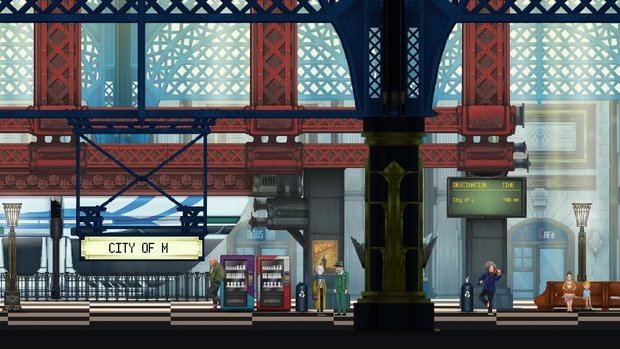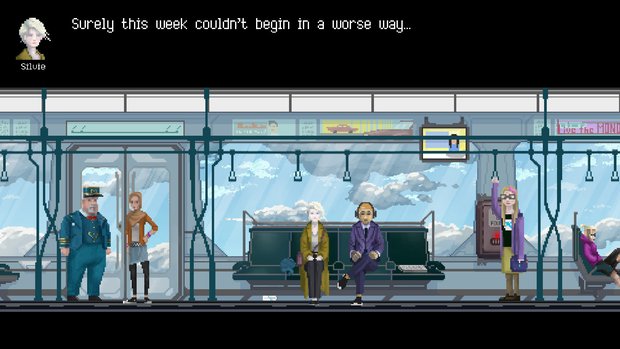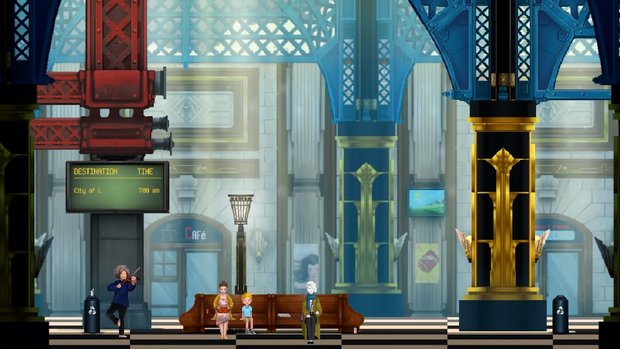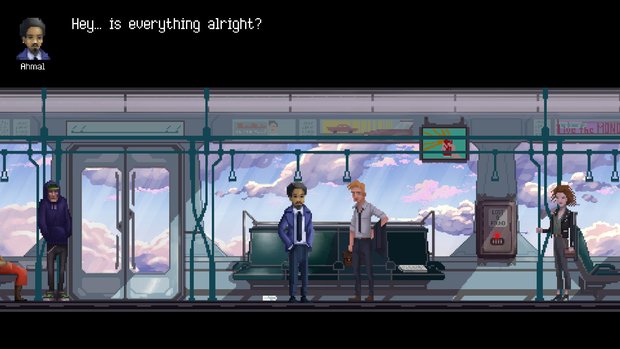Monorail Stories review – Compelling character dramas keep the adventure moving

- 0 Comments
Have you ever commuted by public transit to work? Sometimes the bus or train is full of people – a combination of regular passengers, ticket collectors, and a random cross-section of humanity. Other times it’s the opposite, where you’re sitting there completely alone, lost in your own thoughts, or staring out the window at the world passing you by. These experiences are perfectly encapsulated in Monorail Stories, a unique and very short yet pleasingly replayable character-driven adventure game from Swiss developer Stelex Software.
Monorail Stories relies on the narrative to reach its destination – or rather, to share its journey – and that narrative is delivered through the interactions between various characters on the eponymous monorail. Everything you experience is about people and relationships, as seen through the eyes of two interesting individuals, Ahmal and Silvie. Ahmal lives in L City and commutes to work at a bank in M City, occasionally joined by his younger sister but sometimes riding alone. Travelling in the opposite direction, also for work, is Silvie, who is having relationship problems with her partner Charlie.
We follow their respective journeys – never intersecting yet interconnected – for all five days of the work week, controlling each protagonist in both their morning and evening commutes. The (game) length of each trip changes depending on the task, with some needing just a simple conversation with another person to complete, while others might require you to walk up and down the cars to track something down. Changes between the two playable characters happen as certain story points are reached.

I found the gameplay felt much more natural using a controller, the left stick controlling movement. You can use the keyboard as well, however, the arrow keys moving the current character left or right – there’s no need to walk up or down when you’re in a narrow monorail carriage! With either method, when something or someone can be interacted with, a button prompt will appear when you draw near, and pressing that button will show you a list of interactions you’re able to perform, such as Look or Ask About whatever task you’re pursuing. The mouse works in the main game menu, but doesn’t in the game itself.
At the start of each commute an objective is revealed, always in an organic way through conversation with other passengers or the conductors. Each goal is relatively simple and is typically solved by talking to others or by interacting with items like a vending machine, the intercom, or the onboard toilet. There is a single-item inventory displayed at the top of the screen, although it’s only accessed through the conversations you have with passengers. It’s not for solving puzzles per se, but if you’re holding something you might be able to ask a fellow passenger if they know anything about it.
Usually your assigned quest is something either Ahmal or Silvie can do on their own, but sometimes it will require both to accomplish different parts of it, completely unbeknownst to one another, such as finding and dislodging a person’s ring that has become stuck. There is a massive left-turn surprise later in the game that feels a little weird considering the simple day-to-day tasks you’ve been given to that point, yet it does lead Monorail Stories to a satisfying conclusion.
Despite the seemingly inherent monotony of commuting, none of the days feel repetitive. From locating lost items, to dealing with drunk and hungover sports fans, every day offers something new. As each one ends, you’re given a summary of what both characters did throughout the day, and what made positive or negative impressions they made on other people, so on a different playthrough you’re able to change your approach and get alternate results. These choices make each playthrough different, giving the game a degree of replayability.

Choices matter in Monorail Stories. For example, on Tuesday Ahmal boards the monorail and is standing close to Robert, whom we’ve never met before. Robert has just been laid off from his job and is very despondent, and Ahmal’s responses to him determine the way they interact in the days to come. Sylvie, likewise, has the opportunity to engage with one of the conductors who is stressed and obviously having a very bad day, and your decision to either engage with them and offer some help, or to be abrupt and shut down the conversation has major ramifications further on.
There are many such occasions in Monorail Stories, where the choices you make change the outcome of the story, or at least have major repercussions for how others interact with you. There doesn’t appear to be right or wrong answers, and the story feels authentic whatever options you choose, revealing new layers that you’re able to unravel or not as you see fit. Sometimes conversations have a countdown timer that if missed will make a predetermined choice for you, and these timed interactions appear to be the ones that can make the most difference.
I’m unsure how many endings there are, but on my five playthroughs I had two very different experiences and another that was slightly different, with each subsequent playthrough taking about 30 minutes after the first took closer to an hour. While the main tasks each day are the same, regardless of the choices you make, during replays you can avoid starting conversations you know will not affect the outcome of that day’s task, or click through the dialogue to speed things up.

What makes the experience so rewarding is the eclectic cast and the relationships Silvie and Ahmal form with the others on the monorail. They already have established relationships with some of the other commuters like Yosefka, a nurse who works long hours and regularly sleeps on the monorail, who considers Ahmal a nice guy and is happy to talk to him when approached; or Mark, who regularly sits with Silvie and discusses her and her partner Charlie’s troubles.
Then there are others like the Cat Lady, who seems to be on every commute in either direction, always with a cat sitting in her lap willing to be petted. Or the Mother and Boy (whom we later find out is called Bobby), the Geeky-Looking Girl Ahmal knows nothing about but thinks looks like a scientist, and the Ticket Inspectors who aren’t willing to do anything to help you except check tickets because it’s outside their authority as monorail workers.
All of the characters are voiced, and for the most part are well-acted, especially the two main protagonists Silvie and Ahmal, though some of the minor characters can’t match that same standard. Ticket Inspector M, the Cat Lady, and Bobby stand out in that regard; they’re not awful but they’re consistently not of the same quality, and the contrast between the good and not-so-good is noticeable.
The developers have taken a pixel art approach to the graphics, and both backgrounds and animations are nicely drawn and blend well together. There are only a handful of backgrounds in the game: the three carriages of the monorail being the main ones you will spend the majority of your time in, although there are a couple of close-up scenes triggered at important story moments. While the carriages themselves aren’t the most exciting locations as they’re just seats, rails, and doors, what really make them stand out are the character animations and the moving backdrops outside the windows.
As you walk up and down the cars, only the interior of the carriage you are currently in is visible, with the linking ones showing only the outside of the monorail. As you move into another, that external fourth wall is removed and the inside is revealed. In between the two Art Deco-style city stations where you start and finish each day’s journey, high up in the air the cloud-filled skies through the windows of this hi-tech, top-mounted monorail (with the occasional 50s-sci-fi-looking plane flying past) move along with you and change depending on the time of day. Mornings are bright and sunny while the evenings are naturally darker.
Each of the people you encounter is either standing or sitting, or in the case of the drunk sports fans, lying on the floor passed out, but they all have their own animations when they are idle. The ticket inspector might hold his hand up to his mouth to cough, the nurse’s head nods as she struggles to stay awake, another straightens his tie, and the old lady quietly pets her cat. They’re small details, but along with the gentle swaying of the support handles you would hold onto if you’re standing on public transport, they combine to make the world you’re inhabiting feel alive and immersive.
Adding to that immersion in Monorail Stories are the sound effects and music. The train makes the appropriate sounds as it leaves the station and arrives, while doors opening and closing and intercom messages all leave you feeling like you’re actually there. Each scene is also accompanied by a quiet jazz guitar soundtrack, neither overwhelming nor underplayed, perfectly suiting each scene and the objectives you might have that day.
Final Verdict
Monorail Stories is a self-contained world set within the confines of public transport, but it proves to be a surprisingly ideal setting for a character-driven drama. By nature it’s confined, because there’s nowhere for anyone to go, and yet it isn’t static. It feels like a living world full of people who brought their own stories with them, just waiting to be explored. They aren’t there simply waiting for you to do something to progress, but in this environment you need to reach out to get any results. And when you do, the characters are so well-written that for a while you’ll stop caring about the rest of the world passing outside. There isn’t much challenge and it may be short – a potential negative offset somewhat by its branching paths and replayability – and some of the voice acting is uneven, but with a cast of eccentric characters led by two capable and layered leads, this game is a joy to play and will keep you wanting to take another trip to try something new.
Hot take
It may seem restrictive, but as an interactive character drama, Monorail Stories takes a series of individual narratives and weaves them into a cohesive whole that will really grab you and keep you interested in the lives of strangers who share your commute to and from work each day.
Pros
- Great story with layered depth to uncover through conversation choices
- Colourful cast of unique characters
- Well-drawn pixel art backgrounds and animations
- Jazz guitar soundtrack enhances the atmosphere
Cons
- Lesser quality of some of the secondary character voice acting
- Sudden change in plot direction towards the end can feel a little disconnected from what’s come before
Shawn played Monorail Stories in PC using a review code provided by the game's publisher.

- Advertisement
- Help support AGH by advertising with us











0 Comments
Want to join the discussion? Leave a comment as guest, sign in or register.
Leave a comment